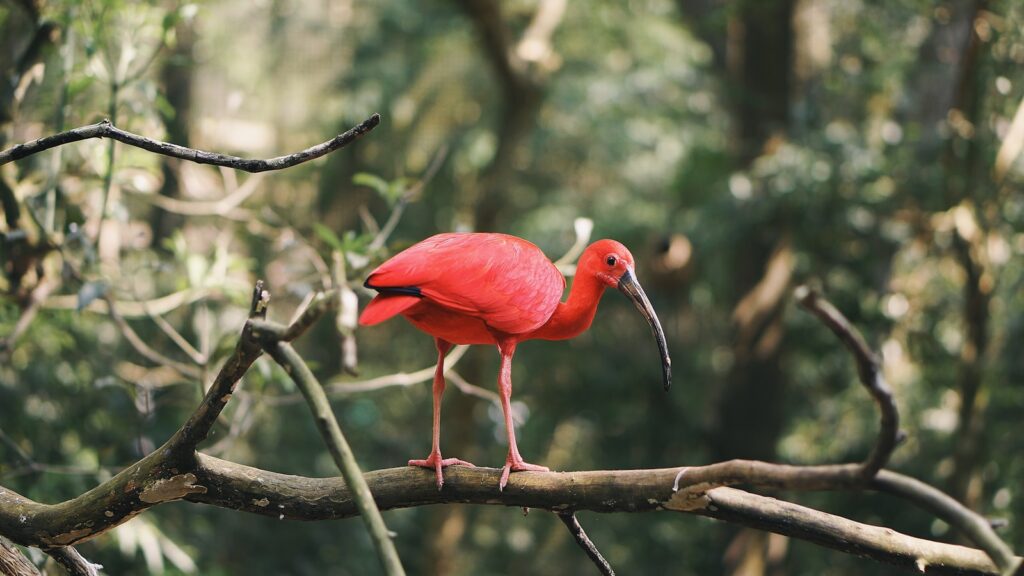In the avian world, where vibrant colors and intricate patterns already astonish observers, certain birds possess an even more remarkable feature that remains invisible to the naked human eye. Some bird species have feathers that fluoresce under ultraviolet light, creating an ethereal glow that transforms their appearance. This phenomenon, hidden from our standard visual spectrum, plays crucial roles in bird communication, mate selection, and possibly even navigation. As humans, we glimpse only a fraction of the avian world’s true visual splendor, but through scientific exploration and special equipment, researchers have uncovered these secret displays that birds themselves can naturally perceive. The discovery of UV-fluorescent feathers has opened new dimensions in our understanding of bird biology, behavior, and evolution.
The Science Behind UV Fluorescence in Bird Feathers

Ultraviolet fluorescence occurs when molecules in feathers absorb UV radiation and re-emit that energy as visible light at longer wavelengths, creating a glowing effect visible under UV illumination. Unlike simple UV reflection, which many birds display, true fluorescence involves energy transformation and produces colors that wouldn’t otherwise be visible. The chemical compounds responsible include porphyrins, psittacofulvins, and specialized proteins that have evolved specifically for this purpose. These fluorescent compounds are either deposited during feather formation or acquired through diet and special preening behaviors. The intensity of the fluorescence can vary significantly between species, with some birds displaying subtle glows while others showcase dramatic, vibrant patterns that completely transform their appearance.
The Remarkable Parrot Family: Champions of Fluorescence

Parrots represent the most extensively studied group of birds exhibiting UV fluorescence, with research confirming this trait in over 95% of parrot species examined. Budgerigars (commonly known as budgies) display particularly striking fluorescence, with their yellow crown and cheek feathers glowing an intense blue under UV light. The vibrant scarlet and yellow plumage of many macaws transforms under UV illumination, revealing patterns invisible in normal lighting conditions. In cockatoos, the white plumage that appears plain to human eyes bursts into blues and purples when exposed to ultraviolet radiation. This widespread fluorescence throughout the parrot family suggests the trait emerged early in their evolutionary history and has been conserved across species, indicating its likely biological importance.
Puffins and Their Extraordinary Glowing Beaks

While not strictly a feather-based fluorescence, the Atlantic puffin (Fratercula arctica) deserves special mention for its remarkably glowing bill, discovered by researchers in 2018. Under UV light, the ornamental ridges on puffin bills fluoresce brilliantly, creating patterns that other puffins can see naturally with their UV-sensitive vision. Unlike some fluorescence that fades after death, puffin bill fluorescence persists even in museum specimens centuries old, indicating extremely stable fluorescent compounds. The research team from the University of Nottingham, who discovered this phenomenon, noted that the fluorescence becomes more pronounced during the breeding season, suggesting it plays a role in sexual selection. This adaptation appears to enhance the already colorful bill, potentially making certain individuals stand out more dramatically to potential mates in the dimly lit conditions of their breeding colonies.
Owls: Fluorescence in Nocturnal Hunters

Several owl species display distinctive patterns of pink fluorescence, particularly in their ventral feathers and wing undersides. The eastern screech owl (Megascops asio) shows vibrant fluorescence that creates a striking contrast against its otherwise camouflaged plumage. Researchers hypothesize that this fluorescence might help owls assess the quality and age of potential mates, as the intensity of fluorescence can degrade with feather wear and exposure to environmental factors. Intriguingly, the patterns of fluorescence often appear in areas typically hidden during normal posture but revealed during courtship displays. The pigments responsible for owl fluorescence include porphyrins, compounds that degrade when exposed to sunlight—potentially explaining why predominantly nocturnal species maintain these molecules while diurnal birds have largely lost them.
Penguins: Unexpected Glow in Polar Environments

Researchers examining king penguins (Aptenodytes patagonicus) discovered that their beak and feathers fluoresce under UV light, creating distinctive patterns visible to other penguins. The yellow-orange plumage on their chest and distinctive beak markings glow particularly vibrantly, potentially aiding in recognition within the crowded colony environment. This fluorescence appears strongest in areas also pigmented with yellow and orange carotenoid pigments, suggesting an interaction between different types of coloration mechanisms. In the challenging visual environment of Antarctic waters, which filters light differently than air, this fluorescence may enhance visibility at the specific depths where penguins hunt and socialize. The discovery challenges previous assumptions about visual communication in polar environments and demonstrates that even in seemingly monochromatic habitats, birds utilize complex visual signals.
The Evolutionary Advantage of Fluorescent Feathers

The persistence of UV fluorescence across numerous bird lineages strongly suggests it confers evolutionary advantages rather than being merely incidental. The most widely accepted theory proposes that fluorescent feathers enhance sexual signaling, allowing birds to assess the health, age, and genetic quality of potential mates with greater precision. For some species, particularly those active in dawn and dusk conditions when UV light is proportionally more abundant, fluorescence may enhance visibility for territory defense or group cohesion. Certain patterns of fluorescence might also serve in species recognition, preventing hybridization in areas where similar species coexist. Some researchers have even proposed that fluorescent feathers could play roles in predator confusion or communication that remains private from predators lacking UV vision, though these hypotheses require further investigation.
Fluorescence as a Sexual Signal

Studies investigating mate choice in budgerigars and other parrot species have demonstrated that individuals prefer partners with more intense UV fluorescence, indicating its importance in sexual selection. Experiments where researchers manipulated the fluorescence of feathers found that birds with artificially reduced fluorescence were less successful in attracting mates compared to their unaltered counterparts. The intensity of fluorescence often correlates with individual health metrics, suggesting it serves as an honest signal of genetic quality that cannot easily be faked. In some species, the fluorescent patterns become more pronounced or change distribution during the breeding season, further supporting their role in courtship. Male and female birds may also display different fluorescence patterns, creating sexually dimorphic signals visible only in the UV spectrum, even when the birds appear identical to human eyes.
Detecting Fluorescence: How Scientists Made the Discovery

The discovery of feather fluorescence required specialized equipment, including UV light sources and filters that block reflected UV while allowing the visible fluorescent emissions to pass through. Early research in the 1970s noted fluorescence in some specimens, but a comprehensive understanding developed only with advances in spectrophotometry and digital imaging in the 1990s and 2000s. Modern studies employ multispectral imaging systems that can precisely quantify the wavelengths emitted and create visual representations of how birds might appear to each other. Field researchers now use portable UV lights to examine wild birds, documenting fluorescence patterns across populations and in their natural habitats. Museum collections have proven invaluable, allowing scientists to examine thousands of specimens across nearly all bird families to map the distribution of this trait throughout the avian evolutionary tree.
How Birds Perceive Their Fluorescence

Unlike humans, birds possess tetrachromatic vision with a fourth cone type specifically sensitive to ultraviolet wavelengths, allowing them to perceive both the UV light that excites fluorescence and the resulting emitted light. This enhanced visual system means birds experience a much richer color palette than humans can imagine, with fluorescence adding another dimension to their visual world. Behavioral experiments have confirmed that birds can distinguish between feathers with different fluorescent properties, even when they appear identical under normal light to human observers. The avian visual system has co-evolved with its fluorescent signals, optimizing its ability to detect subtle differences in fluorescent intensity and pattern. For birds, these fluorescent markings likely appear as distinctly as the most obvious color patterns visible to humans, forming an integral part of how they perceive other individuals.
Geographic and Habitat Patterns in Fluorescent Species

Comprehensive surveys have revealed interesting patterns in the distribution of fluorescent bird species across different habitats and geographic regions. Birds from tropical rainforest environments show particularly high rates of fluorescence, possibly due to the filtered light conditions under the canopy, where UV signals might be more effective. Conversely, birds from open desert habitats tend to show less fluorescence, perhaps because the harsh sunlight would degrade the responsible compounds too quickly. Island species often display more pronounced fluorescence than their mainland relatives, consistent with the pattern of island birds evolving more elaborate signaling systems. Intriguingly, fluorescence appears more common in social species than solitary ones, supporting the communication function hypothesis. These distribution patterns provide further clues about the ecological contexts where fluorescence offers the greatest adaptive advantages.
Conservation Implications of UV Fluorescence

Understanding bird fluorescence has important implications for conservation efforts, particularly in captive breeding programs where artificial lighting rarely includes the UV spectrum that birds would experience naturally. This lighting deficiency could potentially disrupt natural behaviors, including mate selection, which often relies on assessing fluorescent signals. Conservation breeding facilities are increasingly incorporating full-spectrum lighting that includes appropriate UV wavelengths to support normal development and behavior. For wild populations, changes in atmospheric composition and pollution that affect UV penetration could potentially disrupt communication systems relying on fluorescence. Habitat fragmentation might also impact fluorescent signaling by altering the light environments birds experience, potentially creating another subtle but significant conservation concern. Researchers now recommend that environmental impact assessments consider potential effects on UV environments alongside more traditional measures.
Future Research Directions in Avian Fluorescence

The field of avian fluorescence research continues to expand, with scientists exploring several promising directions. Genomic studies are beginning to identify the genes responsible for producing fluorescent compounds, which may help reveal how this trait evolved independently in different lineages. Behavioral ecologists are designing increasingly sophisticated experiments to determine precisely how birds use fluorescent signals in different contexts beyond mate choice. Comparative studies examining closely related species with different levels of fluorescence are helping isolate the ecological factors that drive the evolution of this trait. New technological approaches, including UV-sensitive drones and advanced imaging techniques, are enabling researchers to study fluorescence in previously inaccessible wild populations. As our understanding grows, this once-hidden dimension of bird biology continues to reveal new insights into avian communication and evolution.
Citizen Science Contributions to Fluorescence Research

The accessibility of UV lighting equipment has enabled citizen scientists to make significant contributions to our understanding of avian fluorescence. Hobbyist bird photographers equipped with modified cameras and UV sources have documented fluorescence in species previously unexamined by formal research. Aviculturists and pet bird owners have shared observations of fluorescence-related behaviors that sometimes precede formal scientific documentation. Several major research institutions now run programs that coordinate citizen science efforts, providing protocols for standardized documentation of fluorescence across geographic regions. These collective efforts have greatly expanded our knowledge base, with the Cornell Lab of Ornithology’s fluorescence database now containing entries for hundreds of species examined by both professional researchers and dedicated amateurs. This democratization of research demonstrates how modern technology can enable public participation in expanding scientific knowledge of these fascinating biological phenomena.
The discovery of UV-fluorescent feathers has transformed our understanding of bird communication and perception. What appears as a simple brown, white, or yellow bird to human eyes may be an explosion of dynamic, glowing signals to another bird. This hidden world of avian visual communication reminds us that our perception represents just one way of experiencing reality. As research continues to unveil the mechanisms and purposes behind feather fluorescence, we gain not only scientific knowledge but also a deeper appreciation for the complexity of avian evolution. These glowing feathers stand as a testament to nature’s remarkable ingenuity and the countless adaptations that have evolved beyond human perception, waiting to be discovered through the lens of scientific curiosity.
